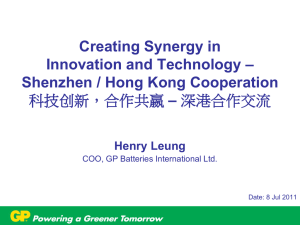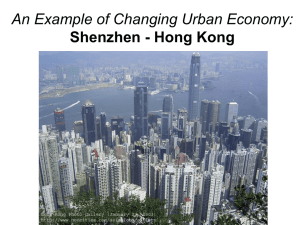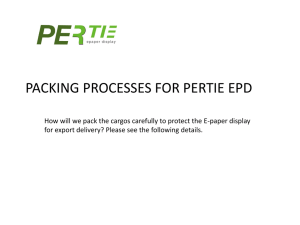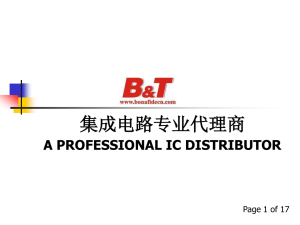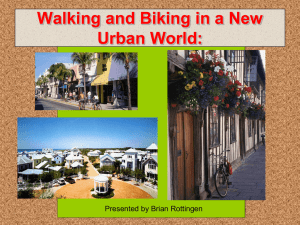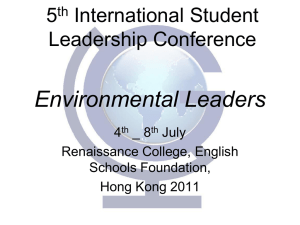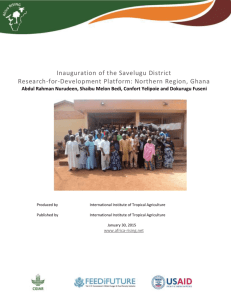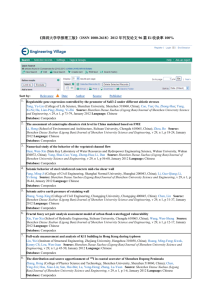Counterpart Cities: Climate Change and Cooperative Action in Hong
advertisement
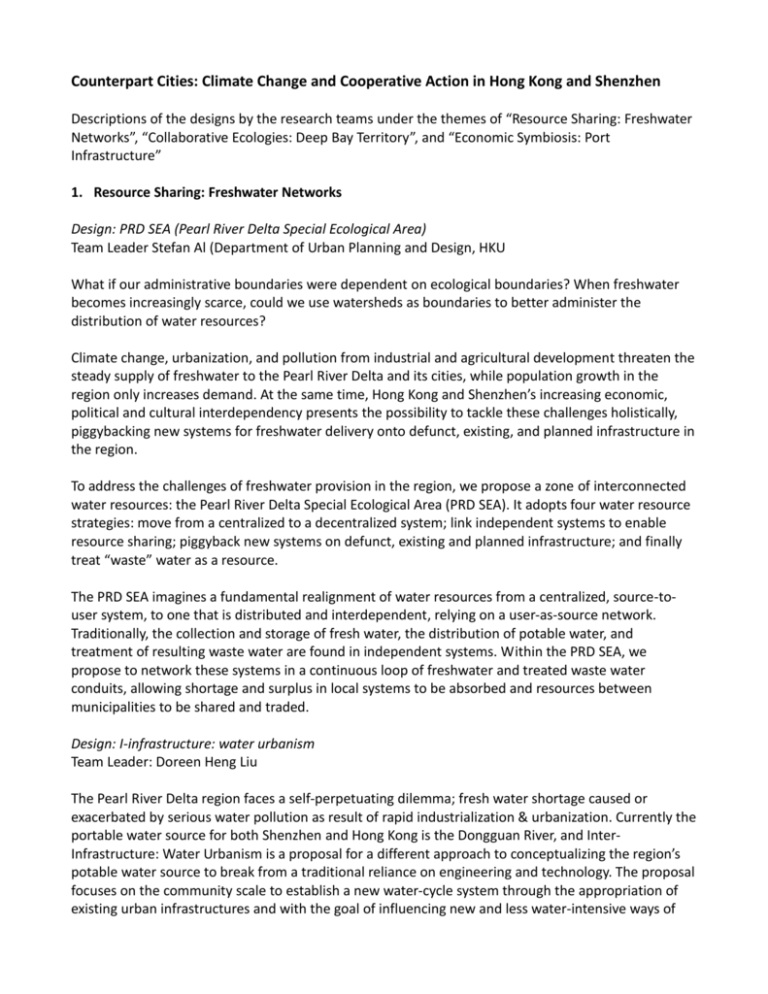
Counterpart Cities: Climate Change and Cooperative Action in Hong Kong and Shenzhen Descriptions of the designs by the research teams under the themes of “Resource Sharing: Freshwater Networks”, “Collaborative Ecologies: Deep Bay Territory”, and “Economic Symbiosis: Port Infrastructure” 1. Resource Sharing: Freshwater Networks Design: PRD SEA (Pearl River Delta Special Ecological Area) Team Leader Stefan Al (Department of Urban Planning and Design, HKU What if our administrative boundaries were dependent on ecological boundaries? When freshwater becomes increasingly scarce, could we use watersheds as boundaries to better administer the distribution of water resources? Climate change, urbanization, and pollution from industrial and agricultural development threaten the steady supply of freshwater to the Pearl River Delta and its cities, while population growth in the region only increases demand. At the same time, Hong Kong and Shenzhen’s increasing economic, political and cultural interdependency presents the possibility to tackle these challenges holistically, piggybacking new systems for freshwater delivery onto defunct, existing, and planned infrastructure in the region. To address the challenges of freshwater provision in the region, we propose a zone of interconnected water resources: the Pearl River Delta Special Ecological Area (PRD SEA). It adopts four water resource strategies: move from a centralized to a decentralized system; link independent systems to enable resource sharing; piggyback new systems on defunct, existing and planned infrastructure; and finally treat “waste” water as a resource. The PRD SEA imagines a fundamental realignment of water resources from a centralized, source-touser system, to one that is distributed and interdependent, relying on a user-as-source network. Traditionally, the collection and storage of fresh water, the distribution of potable water, and treatment of resulting waste water are found in independent systems. Within the PRD SEA, we propose to network these systems in a continuous loop of freshwater and treated waste water conduits, allowing shortage and surplus in local systems to be absorbed and resources between municipalities to be shared and traded. Design: I-infrastructure: water urbanism Team Leader: Doreen Heng Liu The Pearl River Delta region faces a self-perpetuating dilemma; fresh water shortage caused or exacerbated by serious water pollution as result of rapid industrialization & urbanization. Currently the portable water source for both Shenzhen and Hong Kong is the Dongguan River, and InterInfrastructure: Water Urbanism is a proposal for a different approach to conceptualizing the region’s potable water source to break from a traditional reliance on engineering and technology. The proposal focuses on the community scale to establish a new water-cycle system through the appropriation of existing urban infrastructures and with the goal of influencing new and less water-intensive ways of life. A site including a sewage treatment plant and public housing development by the Shenzhen River in Luo Hu is the testing ground for the project. Winding channels and artificial wetlands further purify water after primary treatment and provide public space and amenities to serve the needs of community, and create a self-sufficient water-budget. The design addresses the complexity of city, needs of the people and infrastructure for water through hybridization and inter-relation. The three systems support and intensify each other, working together to maximize the use of limited land and resources. The design draws inspiration from the operations of a circuit-board, a new vertical city is floats above the exiting water treatment plant, reorganizing a fragmented community. This dynamic system of networks connects the existing urban fabric of Shenzhen to the natural wetland ecosystems across the river in Hong Kong, fostering close interactions between the various local communities. In a time of extravagant urban development, this Inter-Infrastructure encourages the re-valuation of our resources. 2. Collaborative Ecologies: Deep Bay Territory Design: Symphony of Blades Team Leader Vincci Mak (Division of Landscape Architecture, HKU) The process of sedimentation is a unique force that singularly shapes the delicate balance of ecologies in the Deep Bay. Although sedimentation occurs naturally, the process has accelerated in recent years due to activities such as rapid urbanization, land reclamation, and other infrastructural projects such as the straightening of the Shenzhen River. Increase in sediment in the Deep Bay reduces its capacity to mediate storm water and increases the risk of flooding in adjacent areas. It also nurtures excessive growth of mangroves around the fringes of the coastline and blocks flood runoff to the sea. If the sedimentation process continues without mitigation, the productive economies and critical urban areas in Hong Kong and Shenzhen would be threatened by increased flooding. We propose to redirect sedimentation in the bay, by influencing the direction of water current as well as sedimentation patterns. Using principles of hydrodynamics, the project simultaneously limits excessive sediment accumulation in the Bay, while harvesting sediment to create a new local lifestyle economy. It also aims to induce mangrove growths at strategic locations to protect against future storm surges. Symphony of Blades brings life to infrastructure; proposing industry, education and lifestyle programming amidst a sequence of sediment-manipulating blades at the mouth of the Deep Bay. The coupling of infrastructure and other urban functions fosters a greater awareness about environmental processes. While the blades harvest excess sediment in the Deep Bay, programs such as a sedimentbrick factory, energy plant, fertilizer plant and facial mud mask factory, make use of the extra resource of sediment in the Deep Bay to serve various industrial activities which benefit the local community and economy, complimenting the vision of a “sediment-relevant” infrastructural experience. Zhubo Design Team Leader Guochuan Feng Sedimental Urbanism explores the ecological, social and political future of the Deep Bay and its inhabitants. A vision of the evolving ecology of the Bay is the basis for a proposal to transform the area into a center for sustainable development in the region. Achieving such a vision requires Shenzhen and Hong Kong to work together with natural processes to create an environment where the city and nature become increasingly indistinguishable and mutually beneficial. Sedimental Urbanism derives its name from the dynamic and sedimentation processes that are rapidly transforming the Shenzhen Bay. It is also a play between the ideas of sediment and sentiment: the physical layers of urbanization that collect to form new ground and the collective unconscious infused into that ground by the people who inhabit it. In its acknowledgement of human satisfaction and happiness as the ultimate measures of value, and its belief in history and culture as essential components of the city, Sedimental Urbanism is openly sentimental. Sedimental Urbanism recognizes that the continual exchange of energy from one form to another—just as in life and death—is as fundamental to the operation of the city as it is to the operation of the universe. Sedimental Urbanism promotes urbanization through erosion, flow, deposition and accretion—manmade and natural. Sedimental Urbanism acknowledges perpetual change as the defining quality of its context—a context of plants, animals and humans as active players on a stage of natural and manmade assemblages, all of which are temporary. 3. Economic Symbiosis: Port Infrastructure FUTUREPORT Team Leader Tom Verebes (Department of Architecture, HKU) The FUTUREPORT project is a design research project which speculates on the future of shipping, land management, manufacturing, environmental sustainability and future urbanisation in the PRD. Through an examination of thirteen ports in the PRD region, there is evidence of an acute limit on the available land for expansion, while older ports have crowded waterways and cannot cater to the largest vessels, due to limitations in the current water depth and logistic movement. As a visionary strategy for the development of a post-industrial economy in the PRD in relation to the future of the SZ-HK ports, a dynamic network of offshore cargo ports is proposed as a new high density urban corridor is proposed in the mouth of the Pearl River, along the future Hong KongMacau-Zhuhai Bridge. This new model of urban and industrial growth is conceived as a series of differentiated scenarios documented at instances from 2011 to 2111, linking the PRD region as a continuous city of 50m population by the year 2111. The direct proximity of offshore ports to industrial production is the primary driver of this new model of symbiosis of Shenzhen and Hong Kong. In addition, sources of clean energy harvesting are proposed as integrated wind and solar farms on offshore islands. Mobile Culture, Creative Community Team Leader Xiongyi Zhu, Guangsheng Zeng With the world growing ever closer through globalization and resources growing ever more in demand, the future of the port lies in efficient and sustainable living. As the land use efficiency of the ports increase, more space becomes available for multi-purpose programs, and port industries are transformed to relate to the human scale with complex functions.. Mobile Culture, Creative Community proposes that logistics, business, living and recreation along the shoreline become more closely inter-connected and interdependent, creating a new and robust port economy. To meet the demand of communication and integration between industries in the new port economy, a new “mobile industry” forms a globally productive network of culture and community, which allows for effective communication and creative cooperation. As a prototype, we combine the cultural and creative industries in Dafen with a new port economy for Shenzhen and Hong Kong. Building on the model of art production in Dafen village as an anchor, Mobile Culture, Creative Community creates a large chain of industries which is diverse, integrated, complex, and influential. Mobile platforms float between markets independently. Creative Communities are assembled specific to the existing conditions and available resources at hand. Being attached to or detached from the land, the Mobile Culture, Creative Community group is continuously transferring and redistributing goods, culture, and knowledge. The Dafen prototype also inspires us, that as an open platform available to the public art becomes part of the community and is no longer restricted to those with artistic training, but becomes a livelihood for any person. Mobile Culture, Creative Community creates a point of exchange at which people from different countries or cultures, with diverse backgrounds, and varied professional skills, can think, talk, create, and work together for the production of culture.
